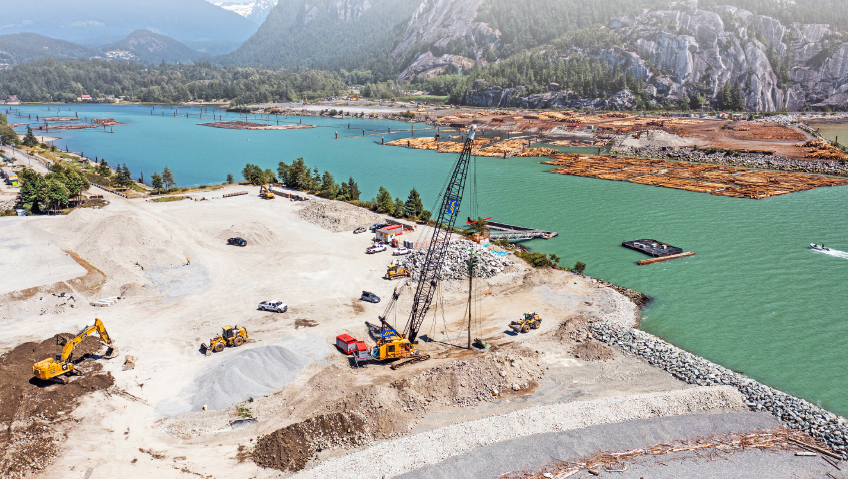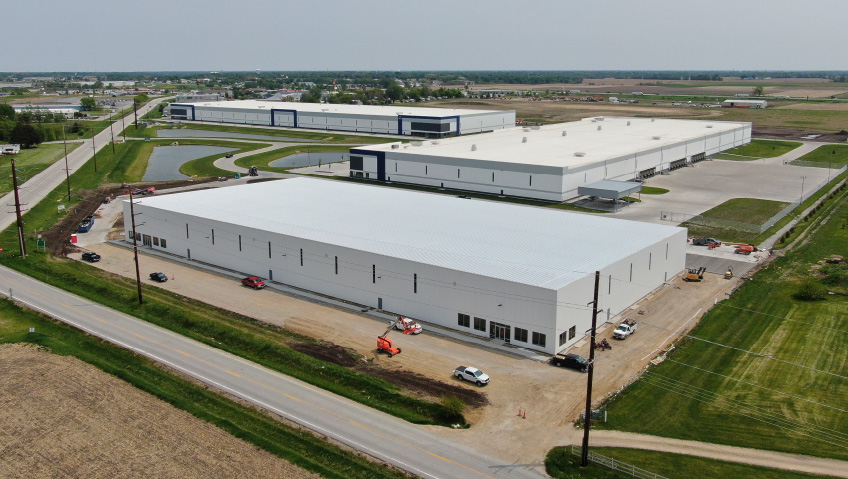Menard Canada uses innovative equipment and treatments to enhance, strengthen, and stabilize soil at construction sites prior to building. The company’s ground improvement solutions reduce settlement, prevent liquefaction, and increase support and the bearing capacity of buildings without the need for deep foundations. Based in Brossard, Quebec, with offices across Canada, the company also offers measures to address seismic risk in earthquake-prone areas.
“We are a specialized contractor… We work everywhere there are poor ground conditions, where there’s potential for ground improvement and soil optimization,” explains Senior Vice President Hubert Guimont, P. Eng.
The services Menard Canada provides include the installation of vertical drains, slurry walls, and Controlled Modulus Columns (CMC), dynamic compaction, compaction grouting, and soil mixing. Vertical drains (also called wick drains) are artificial drainage pathways positioned in soil that is soft and compressible. A slurry wall (soil-bentonite or cement bentonite) is an underground barrier with low permeability that reduces water runoff. Dynamic compaction densifies soils, while compaction grouting densifies and stabilizes soils that are loose, granular, and possess low load-bearing capacity. In soil mixing, a special auger mixes a binding agent with cement-like qualities with soils to create a “natural concrete.”
Controlled Modulus Columns (CMCs), meanwhile, are “concrete columns placed in a grid network” in the ground, displacing soil laterally and creating a new load distribution between the soil and the CMCs, explains the Menard Canada website. The soil reinforcement and densification action improves ground characteristics. Not to be mistaken for deep foundational elements, CMCs can be applied to organic clays, soft soils, and loose sands up to 50 metres deep, without producing excess soil that has to be removed.
Menard Canada’s ground improvement techniques offer an alternative to traditional deep foundation techniques like piles and pre-construction methods involving soil excavation and off-site disposal. These conventional practices can be expensive, time-consuming, and negatively impact the environment, notes Guimont. Optimizing soil, by contrast, is less pricey, speedier, and more eco-friendly.
“Our aim is to work with what [soil] we have to bring it up to its maximum potential. So, in that sense, we’re also environmental. We reduce the carbon footprint, because we use what [soil] we’ve been given,” explains Guimont.
Menard Canada matches its cutting-edge ground improvement techniques with a progressive, client-centric attitude: “We’re kind of a young team, and we adapt to the client’s needs. We’re not like that stubborn contractor that says, ‘My way or the highway!’” says Guimont. “Menard’s Style,” as the company puts it, is all about curiosity, simplicity, entrepreneurship, and a spirit of fun.
“We’re not just a typical service provider. We want to make sure our contribution is meaningful. We really want to help the client,” explains Guimont.
Tied in with this ethos is a philosophy the firm dubs, “Less is More,” whereby, while fully acknowledging the complexity of certain projects, the company aims to streamline its processes.
“We don’t want to make things more complicated; we want to make things easier. So, our solution should be easier and produce less carbon, less work, less volume, less of everything, more Menard!” states Guimont.
For most projects, the company works with general contractors as part of a larger construction team. That said, Menard Canada also partners with developers, architects, and engineers. Ports, airports, highways, railways, buildings, processing and energy plants, mines, and housing are some of the main markets served by Menard Canada, and the firm is eager to expand to new sectors such as construction sites for EV (Electric Vehicle) plants.
Key projects the company has worked on include a new distribution center and a brewery for Molson Coors near Montreal, where Menard Canada was hired to perform soil improvement procedures prior to construction. The firm worked on the project from September 2018 to June 2019. The surface area for the facility—which also included loading docks and storage tanks—came to 81,250 square metres.
Ground analysis revealed metres of silty clay on the surface of the proposed construction site, followed by layers of loose silt and clay, dense silt and clay, dense till made up of silty sand, then bedrock. The traditional approach “would have been to do piles and structural slabs, and the cost would have been prohibitive. It would have been a huge cost because the material was clay over a certain thickness. So, it was not suitable for slab on grade,” says Guimont.
Instead, Menard Canada used vertical drains and CMCs to prepare the ground. “The controlled modulus columns (CMCs) were built with up to three rigs on working platforms divided into six different zones depending on final slab elevation and heave of the soil after building CMCs… The levels of CMC cutoff went up to three metres deep to fit the foundations. Reinforcing bars were added to protect the CMCs against frost and for the CMCs taking up heavy loads,” explains a Menard Canada information sheet.
Menard Canada also worked on Highway 91/17 in Delta, British Columbia, from late 2020 to July 2021. The British Columbia Ministry of Transportation and Infrastructure wanted to upgrade a corridor consisting of Highway 91, Highway 17, and the Highway 91 Connector in the province. “All of the infrastructure had to be upgraded for seismic behaviour,” notes Guimont.
Soft, shallow, compressible soil conditions, however, presented a challenge. Menard Canada installed stone columns to depths of nearly 35 metres to reduce the risk of liquefaction, which in turn enhanced the ability of bridge foundations, abutment walls, embankments, and retaining walls to tolerate seismic forces. The area impacted by the stone columns came to 12,500 square metres. The project also featured the use of dynamic compaction and vertical drains, which impacted 2,331 and 16,000 square metres respectively.
A third project saw Menard Canada doing ground improvements on a construction site for three warehouses in Ajax, Ontario. Menard Canada commenced work in September 2022 and finished in November 2023. Here, the site featured sandy silt/silty sand on the surface, and Menard Canada relied on vertical drains, dynamic compaction, and controlled modulus columns to optimize the ground.
CMCs were installed “to provide the necessary support for the structure, ensuring the performance of the slab and eliminating the risk of post-construction settlement above the underlying soft deposit,” reads Menard Canada information.
Such projects underline the company’s enthusiastic embrace of controlled modulus columns. “When it comes to large warehouses and industrial buildings, CMCs are a very efficient way to build,” notes Guimont, contrasting these columns with “piles and structural slabs.” He adds, “We’ve been approached by several [EV] battery plant developers to look at the potential for building with CMCs.”
Regardless of the work involved, employee safety is top-of-mind in everything the company does. “Our people are the most important tools of our toolbox, so we want to keep them safe. We implement a safety culture around that,” explains Guimont.
To this end, worksites are routinely inspected, safety-related incidents are recorded and investigated, and employees are encouraged to turn down tasks they feel are unsafe and to communicate any safety issues they might have. Menard Canada offers health and safety training for new and veteran staff members alike. These efforts have been recognized, and the company has achieved COR (Certificate of Recognition) status for its safety programs.
Menard Canada was originally founded in 1971. Called Geopac at first, the company was purchased in 2007 by the Menard Group—a much larger organization based in France with divisions in over 80 countries around the world. A decade after the purchase, Geopac was renamed Menard Canada. Menard Canada currently has branches in Vancouver and Kelowna, BC; Calgary, Alberta; Hamilton, Toronto, and Ottawa, Ontario; and Montreal, Quebec, in addition to the Brossard headquarters.
The Menard Group, which includes a soil investigation firm called ConeTec and an environmental remediation company called Remea, has approximately 2,500 employees in over 80 countries. For its part, Menard Canada has “roughly 150 to 200 people,” says Guimont.
In terms of new hires, “one of the personal qualities I’m looking for is someone who is motivated. That’s the first thing. And of course, curiosity [is another factor],” he continues.
Going forward, the Menard Canada team plans to do more soil structure interaction (“earthquake engineering,” says Guimont), while increasing its presence in the mining market. Menard offers stone columns, soil mixing, slurry walls, vertical drains, dynamic compaction and other services for clients in the mining sectors, and these solutions reinforce soils to improve support for mining structures and reduce the impact of tailings seepage. Such measures improve safety and environmental conditions at mines while helping clients meet regulatory requirements.
Challenges facing Menard Canada include finding appropriate workers: “We’re always looking for new people. We need more and more people—skilled people. To sustain growth, and sustain the business, we need people,” says Guimont. To encourage new applicants, the company maintains an internship program and does outreach with universities and other schools.
Over the next five years, in addition to strengthening the company’s core competencies, “I definitely want us to be more known in the mining industry, and in the western part of the country, for our earthquake engineering capabilities,” says Guimont.






